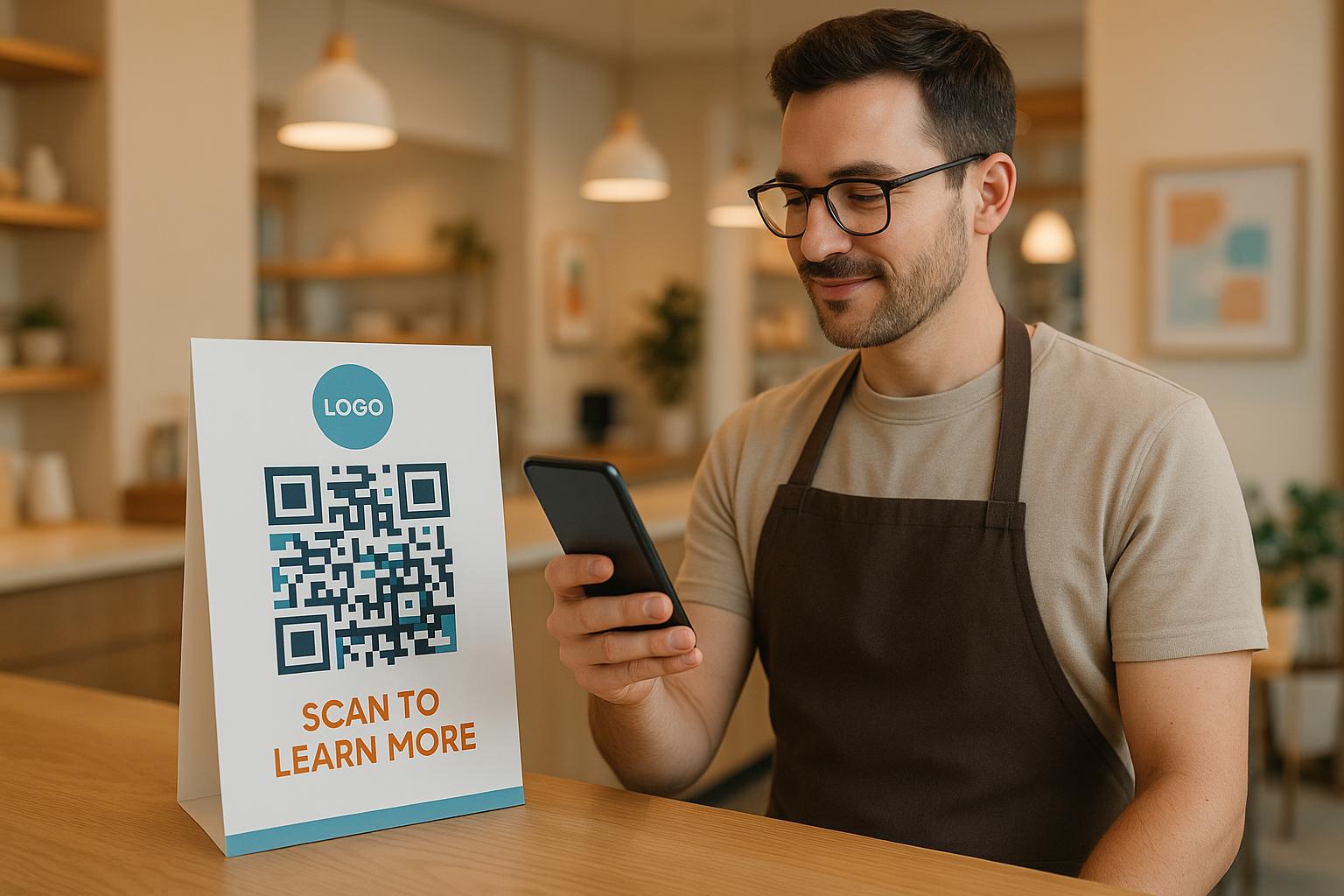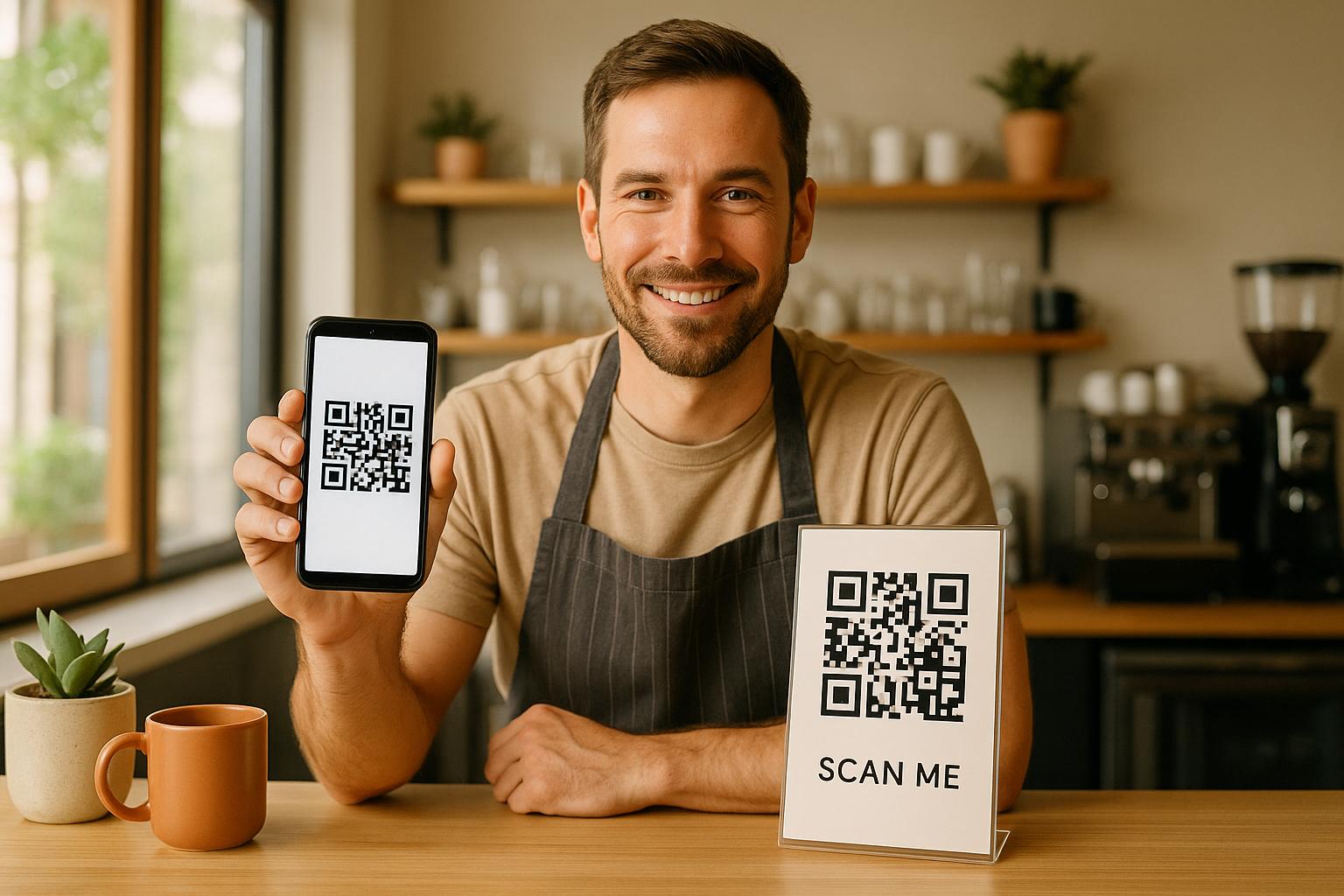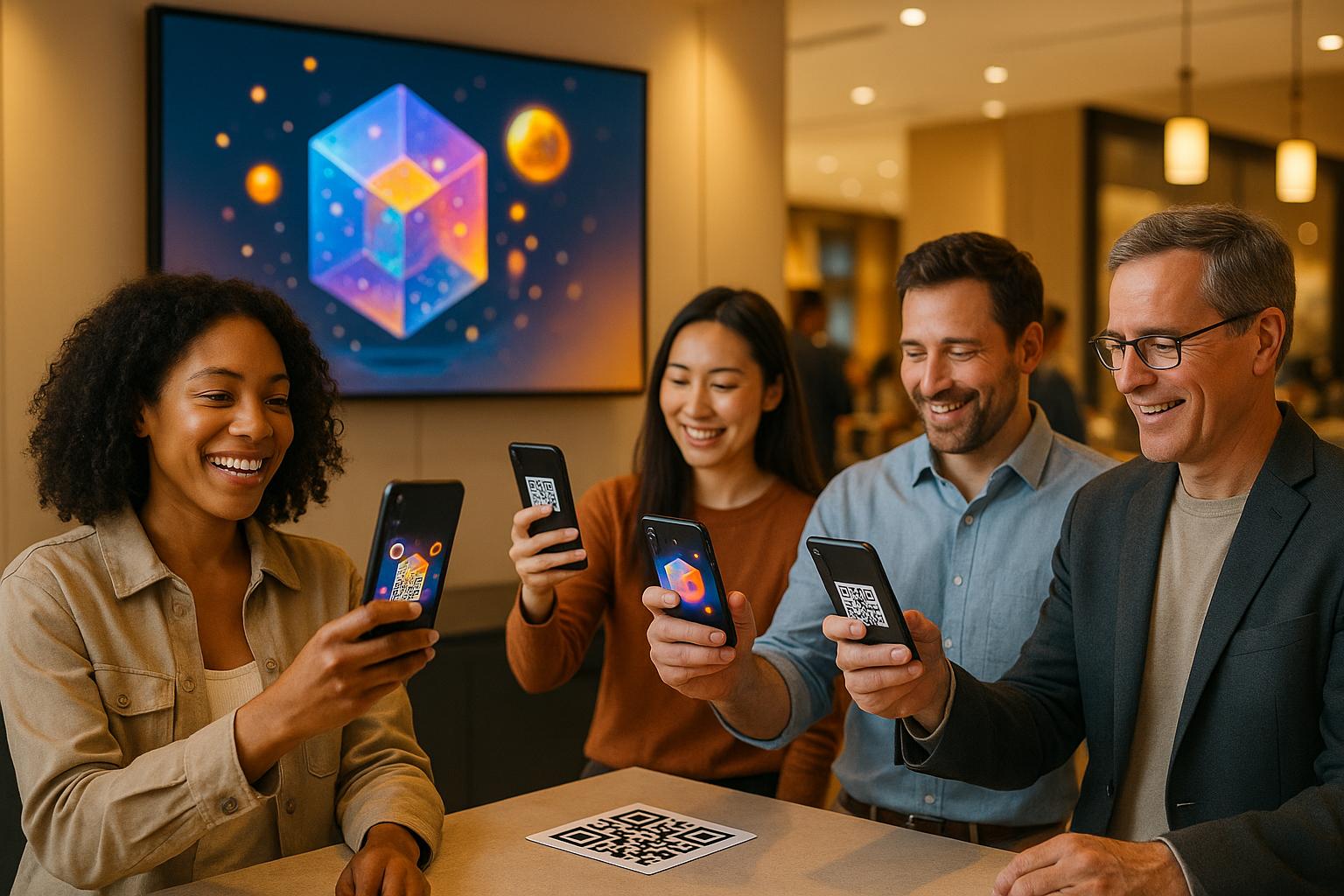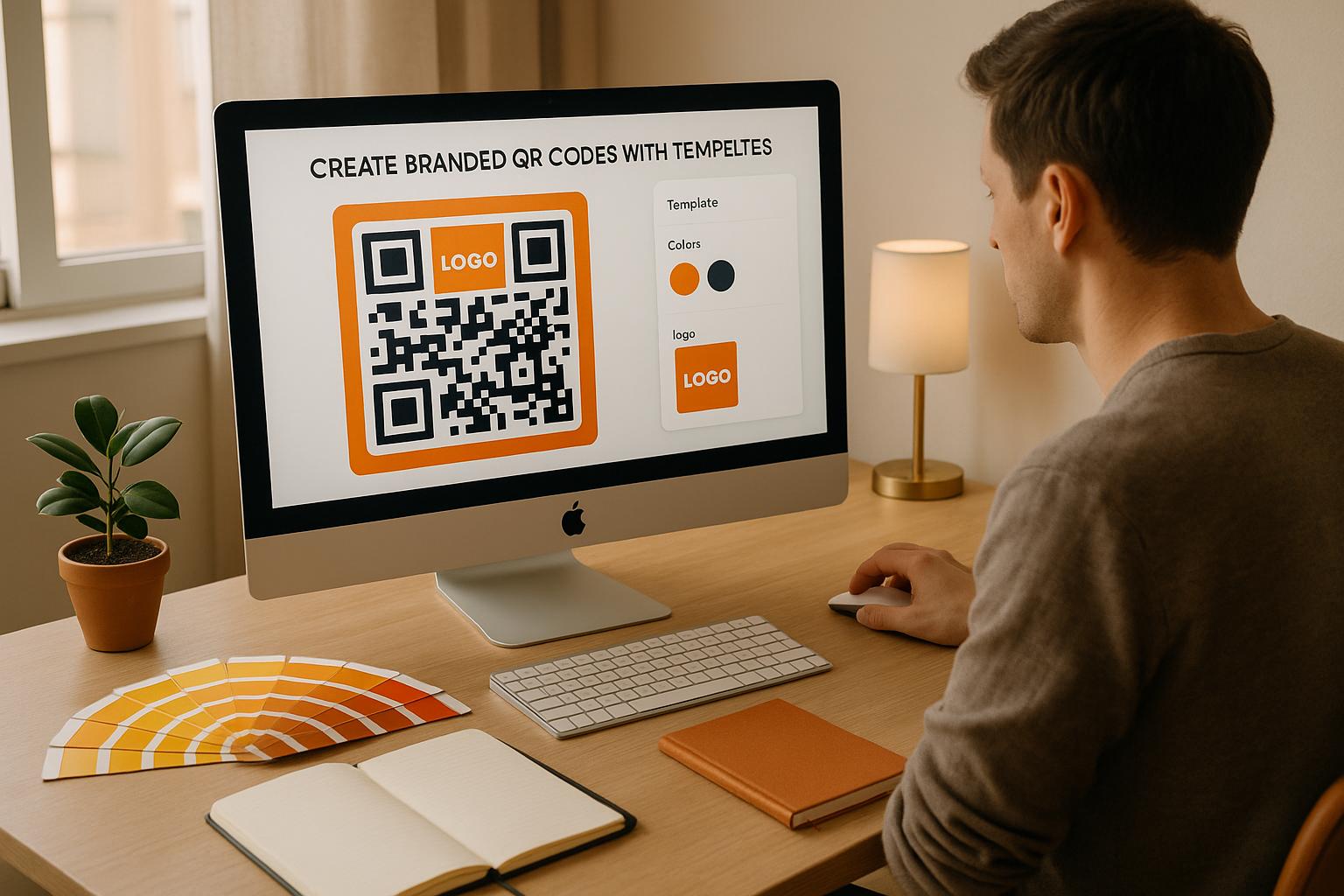QR codes are a simple way to connect offline materials to digital content. For small businesses, they offer a cost-effective way to boost engagement, track campaign performance, and simplify customer interactions. Here’s a quick guide to getting started:
- Set Clear Goals: Use QR codes to drive website traffic, increase social media followers, collect reviews, or facilitate app downloads.
- Choose the Right QR Code Type: Options include URL codes, vCard codes for contact sharing, PDF codes for documents, and social media codes.
- Customize Your QR Code: Add your brand colors, logo, and clear calls-to-action for better recognition and trust.
- Strategic Placement: Place QR codes on business cards, product packaging, menus, posters, and even vehicles. Ensure proper size and test functionality.
- Track Performance: Use dynamic QR codes to monitor scans, locations, and user data, and adjust campaigns based on insights.
- Ensure Accessibility: Position QR codes for easy scanning, add clear instructions, and provide alternative options like written URLs.
With QR codes becoming a regular habit for 59% of consumers, they’re a practical tool for small businesses to engage customers and measure success.
QR Code Marketing Strategies for Small Businesses 2025
Set marketing goals and identify QR code uses
Before diving into QR code creation, it’s crucial to set clear goals. These goals will shape decisions about where to place QR codes, what content they link to, and how their performance is tracked. Think of these objectives as the blueprint for a successful campaign.
Define your marketing goals
Start by pinpointing measurable outcomes that align with your business priorities. QR codes are a powerful tool to connect offline and online interactions seamlessly.
Increase website traffic: For many small businesses, driving more visitors to their website is a top priority. QR codes simplify this by eliminating the need for customers to type out URLs. Tools like a link QR code generator can help direct people from physical materials – such as flyers or posters – straight to your homepage or a specific landing page.
Boost social media engagement: Placing QR codes on business cards or product packaging makes it effortless for customers to find and follow your social media profiles. A Facebook QR code or Instagram QR code can take them directly to your pages, bypassing the need for manual searches. This is especially effective as 54% of shoppers aged 18–29 have interacted with marketing-related QR codes.
Drive sales and conversions: QR codes can lead customers directly to special offers, product pages, or booking systems. For example, e-commerce businesses can include QR codes in traditional ads to guide users to specific product pages, while service-based companies might use them to link to appointment scheduling forms.
Facilitate app downloads: QR codes are a smart way to simplify app downloads. Instead of asking users to search for your app in stores, an app QR code generator can take them directly to your app’s download page on the App Store or Google Play Store.
Collect customer reviews: Online reviews influence the purchase decisions of 93% of customers. By using a Google Review QR code on receipts or follow-up emails, you can make it easier for customers to leave feedback, boosting your online reputation.
Aligning these goals with customer behavior is essential. With 59% of consumers now viewing QR code scanning as a regular habit, businesses have a ready audience for well-thought-out campaigns.
Common QR code uses for small businesses
Once your objectives are clear, it’s easier to decide how QR codes can address real customer needs. Their versatility means they can be applied in countless ways across industries.
Contactless payments and transactions: QR codes are becoming a go-to payment method. According to Square‘s 2025 Future of Commerce report, 67% of retailers consider QR codes a convenient option. Small businesses can use them to accept payments through mobile apps, speeding up checkout and reducing the need for physical card readers.
Digital menus and ordering: The restaurant industry has embraced QR codes for convenience. In fact, 74% of restaurant owners report that QR code–enabled ordering has streamlined their operations. Cafes and bars can use table-side QR codes to link to digital menus, allowing customers to browse and place orders without waiting for staff.
Contact information sharing: QR codes make networking and communication easier. A vCard QR code on business cards allows customers to instantly save your contact details, while service businesses can use them to share information and receive callbacks.
Product information and education: QR codes can provide instant access to detailed product information. For example, businesses can place QR codes on product labels to link to usage instructions, ingredient lists, or demo videos – perfect for healthcare products, supplements, or technical equipment.
Event promotion and registration: QR codes simplify event marketing. Placing them on tickets, social media posts, or printed materials can direct attendees to registration pages or even add events to their calendars using a Google Calendar QR code.
Wi-Fi access: Forget complicated passwords. A Wi-Fi QR code lets customers connect to your network with a quick scan, improving their experience and encouraging them to stay longer.
File and document sharing: Need to share catalogs, price lists, or manuals? A PDF QR code provides instant access to documents without requiring email exchanges or physical copies.
The best QR code applications solve real problems or make processes easier. With 47% of customers finding QR codes helpful in today’s commerce landscape, the focus should always be on providing convenience and value.
Take a closer look at your customer journey. Where can QR codes remove unnecessary steps or deliver instant value? Whether you’re a marketing agency developing campaigns or a construction company sharing project updates, the key is to align QR code functionality with customer needs.
Choose and Customize Your QR Code Type
 Choosing the right QR code type is a critical step in aligning your marketing strategy with your goals. Once you’ve identified your objectives, the next move is to pick a QR code type that directly supports those goals. Customizing the code further helps solidify your brand presence and builds trust with your audience.
Choosing the right QR code type is a critical step in aligning your marketing strategy with your goals. Once you’ve identified your objectives, the next move is to pick a QR code type that directly supports those goals. Customizing the code further helps solidify your brand presence and builds trust with your audience.
Pick the Right QR Code Type
The type of QR code you select depends on what you’re trying to achieve and the kind of content you want to share. Here’s how different QR code types can serve specific purposes:
- URL and Link QR Codes: These are great for driving traffic to a website. Whether it’s your homepage, a product page, or a landing page with special offers, a link QR code generator can make the connection seamless. Perfect for offline-to-online engagement through flyers or posters.
- vCard QR Codes: Make networking effortless by letting users save your contact details instantly. A vCard QR code generator is a professional way to share your information.
- PDF QR Codes: Forget the hassle of emails or printed handouts. Use a PDF QR code generator to share documents like product catalogs, manuals, or price lists. Industries like healthcare and construction find this particularly useful.
- Social Media QR Codes: Simplify how customers find and follow your social profiles. Direct them instantly with tools like a Facebook QR code generator or Instagram QR code generator.
- App QR Codes: Help users download your app directly from their device’s app store. An app QR code generator reduces friction and increases download rates.
- Google Maps QR Codes: Make it easy for customers to find your physical location. Businesses like restaurants, cafes, and retail stores can use a Google Maps QR code generator on business cards or other materials.
When deciding between static and dynamic QR codes, think about your long-term needs. Static codes are great for fixed information, but dynamic QR codes offer flexibility. They allow you to update the destination without reprinting materials and track useful metrics like scan locations, times, and device types.
"Don’t push people to where you want to be; meet them where they are." – Meghan Keaney Anderson, VP of Marketing, HubSpot
This advice is directly applicable to QR code strategy: choose types that match your audience’s needs and actions.
Add Branding to Your QR Codes
Customizing QR codes with your branding not only strengthens your identity but also encourages trust and engagement.
- Color Customization: Match your QR codes to your brand’s color palette. Use your primary colors while ensuring high contrast with the background for easy scanning. Many QR code tools let you input specific hexadecimal color values for consistency.
- Logo Integration: Add your logo to the center of the QR code to create an immediate brand connection. Thanks to built-in error correction, this won’t affect functionality.
Real-world examples show how effective this can be. In 2023, Hershey’s worked to create a holiday campaign featuring QR codes on Hershey’s Kisses boxes. These codes, designed to match the product’s packaging, allowed customers to send video messages, enhancing the seasonal experience. Similarly, Louis Vuitton partnered with artist Takashi Murakami to craft visually striking QR codes, while PayPal incorporated its logo and colors into its QR codes for cashless transactions.
- Frames and Calls-to-Action: Use frames to highlight QR codes with brand colors, taglines, or instructions like "Scan for Menu" or "Get 20% Off." These elements guide users while reinforcing your branding.
- Consistency Across Materials: Whether your QR codes appear on business cards, product packaging, or vehicle graphics, they should maintain a unified look.
- Testing for Functionality: Always test branded QR codes across different devices and distances. Ensure there’s enough white space around the code and that the contrast is sharp enough for reliable scanning.
The goal is to create QR codes that your audience instantly associates with your brand while ensuring they’re easy to use. When done right, branded QR codes become a powerful tool for blending marketing goals with brand recognition.
Place QR Codes on Marketing Materials
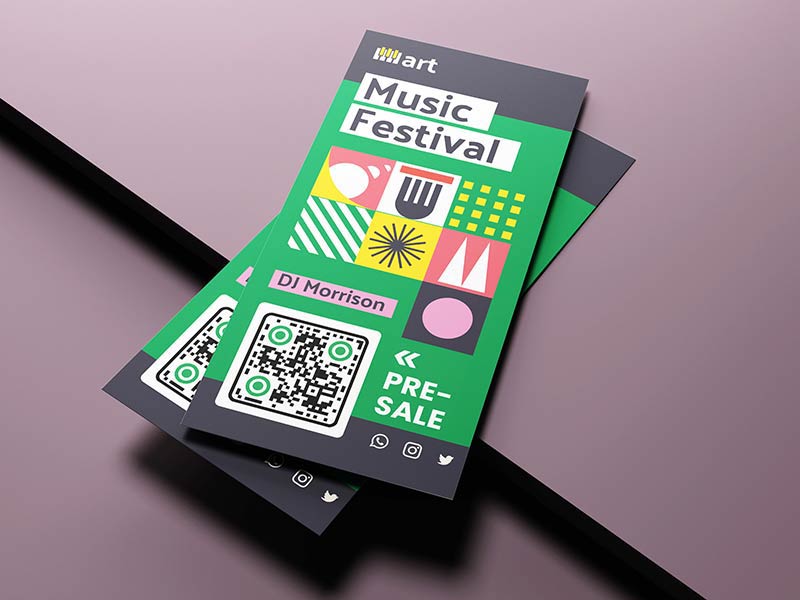 Strategically placing QR codes on your marketing materials can make a huge difference in how effectively they engage your audience. Where and how you position these codes directly influences scan rates and user interaction.
Strategically placing QR codes on your marketing materials can make a huge difference in how effectively they engage your audience. Where and how you position these codes directly influences scan rates and user interaction.
"By carefully choosing the QR code placement, you can ensure that your audience can easily and seamlessly interact with your content."
Once you’ve customized your QR codes, the next step is to position them where your audience is most likely to interact with them.
Select Physical and Digital Locations
Think about the variety of ways QR codes can be used and place them where they’ll have the most impact. Physical marketing materials are a great way to connect offline audiences with your digital content. For example, business cards are an excellent spot for QR codes, allowing instant access to contact details through vCard codes. Make sure the code is prominent but doesn’t overshadow key contact information.
On flyers and posters, position QR codes at eye level so they’re easy to notice. Avoid placing them in areas where they can be missed or overlooked. For product packaging, consider locations that customers naturally see when making a purchase or opening the product.
Real-world examples highlight the effectiveness of smart QR code placement. In 2012, Taco Bell and Frito Lay used QR codes on taco holsters during the launch of Doritos Locos Tacos, directing users to a mobile landing page with games and sweepstakes. Content was updated weekly, keeping users engaged. Similarly, Heinz added QR codes to their bottles for the "Join the Growing Movement" campaign, encouraging customers to make sustainability pledges, which Heinz supported by planting trees for each participant.
Digital placements are equally impactful, bridging online and offline interactions. For instance, QR codes in email campaigns should be placed near the top for visibility. Social media posts, website banners, and digital ads can also include QR codes to drive specific actions. Netflix’s 2016 promotion of the Gilmore Girls revival is a great example. They partnered with cafes to create "Luke’s Diner" pop-ups and printed Snapchat QR codes on coffee cup sleeves, unlocking special filters when scanned.
Here are some placement ideas tailored for different industries:
- Restaurants: Table tents, menus, receipts, and window displays
- Retail stores: Product tags, checkout counters, shopping bags, and storefront windows
- Healthcare facilities: Waiting room posters, appointment cards, and patient information sheets
- Real estate: Property signs, listing flyers, and vehicle wraps
Once you’ve chosen your placement, make sure your QR codes are functional and user-friendly.
Ensure Proper Size and Test Functionality
The size of your QR code matters. The minimum size should be 2 cm x 2 cm (0.8 inches), but this increases depending on the expected scanning distance. A good rule of thumb is the 10:1 ratio: for every 10 units of scanning distance, the QR code should be 1 unit in size. For example, a QR code meant to be scanned from 10 feet away should be about 12 inches square.
Testing is just as important as placement. Check your QR codes in various lighting conditions, from dim to bright, and at different distances to ensure they’re easy to scan. Try scanning them with different devices and camera apps to confirm they work across platforms.
"Make sure you understand the purpose of your QR code and have realistic expectations for its use. It is not a magic bullet and should be used as part of a larger strategy. Also, ensure your codes are high quality and that you have tested them properly." – Shawn Plummer, CEO of the Annuity Expert
Other factors to consider include internet and cellular connectivity in the placement area, as poor reception can make even a well-designed QR code useless. For outdoor signage or vehicle wraps, durability is key – codes exposed to weather or wear might fade or become damaged over time. Using QR codes with higher error correction levels can help maintain scannability even if part of the code is compromised. Regularly inspect and replace damaged codes to ensure they remain functional.
When placing QR codes, think about user comfort. Make sure they’re easy to scan without requiring awkward movements, and avoid locations that might create challenges for people with mobility issues. Including a short URL near the QR code as a backup option is a simple way to ensure users can still access the content if scanning fails.
Testing shouldn’t stop after launch. Regularly monitor how your QR codes are performing and adjust based on user feedback and scan data. Combining thoughtful placement with rigorous testing ensures your QR codes provide a seamless experience and help you meet your marketing goals.
sbb-itb-74874c9
Track and Improve QR Code Performance
Once you’ve strategically set up and placed your QR codes, the next step is crucial: tracking and analyzing their performance. The data you gather will guide your future marketing efforts and help you make the most of your investment.
"Marketing teams that implement QR codes – especially if they use newer, dynamic QR code technology – gain competitive advantages in engagement, data collection, and revenue generation, transforming every consumer touchpoint into an opportunity for meaningful connection." – Sharat Potharaju, Co-Founder and CEO at Uniqode
QR codes consistently outperform other marketing channels. For example, the average click-through rate for QR code campaigns is 12.80%, far surpassing Google display ads (5.06%), email marketing (2.60%), Facebook ads (0.90%), and Instagram feed ads (0.22%).
Use Dynamic QR Codes for Data Tracking
![]() Static QR codes don’t provide any tracking information. On the other hand, dynamic QR codes offer detailed insights into campaign performance. Unlike static codes, which embed information directly into their graphics, dynamic codes use a redirect URL, allowing for robust tracking capabilities.
Static QR codes don’t provide any tracking information. On the other hand, dynamic QR codes offer detailed insights into campaign performance. Unlike static codes, which embed information directly into their graphics, dynamic codes use a redirect URL, allowing for robust tracking capabilities.
Dynamic QR codes can capture data such as:
- Number of scans
- Geographic location (city and country)
- Device type, browser, and operating system
- Time of scan
In fact, 95% of businesses report that QR codes help them gather essential first-party data. This makes them a powerful tool for understanding customer behavior.
For a deeper analysis, integrate your QR code solutions with tools like Google Analytics. This setup lets you view QR code metrics alongside broader user behavior data, giving you a complete picture of how people interact with your content. Adding UTM parameters to your QR codes can help you track offline campaigns with precision, linking physical marketing efforts to your digital analytics.
For even more advanced tracking, consider retargeting users who scan your codes. Tools like Google Tag Manager and Facebook Pixel allow you to serve ads to these users later, turning a single scan into multiple engagement opportunities.
Review Campaign Results
Analyzing the data from your QR code campaigns can uncover valuable insights to refine your marketing strategies. The key is to focus on the metrics that align with your goals and compare performance across different placements and campaigns.
Take Flipkart‘s Big Billion Days campaign, for example. They used gamified QR codes in print and TV ads, tracked scan-through rates, and adjusted their designs mid-campaign. As a result, they boosted their scan-through rate by 15%, generated over 2 million scans, and engaged 536,000 visitors.
Another success story comes from HSBC UK‘s partnership with Shelter. Their QR codes, aimed at promoting bank accounts for the homeless, led to a 52% increase in accounts within just two weeks. Impressively, one in five people who scanned the QR code became regular donors.
Here are some key metrics to track based on campaign goals:
- Lead Generation: Scan rates, form completions, cost per lead
- Sales Promotion: Scan rates, redemption rates, revenue per scan
- Brand Awareness: Total scans, geographic reach, repeat scans
- Event Promotion: Scan rates, registration conversions, attendance
Tourism New Brunswick ran a direct mail campaign featuring QR codes on flyers and CTV ads, directing users to a contest landing page. The direct mail piece achieved an engagement rate of 1.77%, with 209 users landing on the main page and 80% proceeding to the contest page.
When reviewing your results, consider the entire user journey. For example, PatientPoint‘s healthcare marketing campaign tracked QR codes on advertising panels in hospitals, clinics, and self-checkout stations. This effort resulted in 270,000 scans and 208,000 engaged visitors.
Make Improvements Based on Data
The real value of data lies in how you use it to refine your campaigns. Start by identifying your top-performing placements and campaigns. For instance, if QR codes on business cards outperform those on flyers, consider focusing more resources on distributing business cards. Similarly, if certain locations yield better results, expand your presence in those areas.
A/B testing is another powerful tool. Experiment with different QR code designs, placements, and calls-to-action to see what resonates most with your audience. For example, restaurants might test QR codes on table tents versus menus, while retail stores could compare product packaging against checkout counter placements.
Timing also plays a role. If your data shows peak scanning activity during lunch hours, schedule your promotions accordingly. For healthcare facilities, morning appointments might yield higher engagement than later in the day.
Pay close attention to the user experience. If scan rates are high but conversions are low, the issue might lie with your landing page. Ensure that the content behind your QR codes provides real value, whether it’s exclusive discounts, helpful information, or entertaining content.
A great example comes from the M+ Museum in Hong Kong. They used multilingual QR codes in their galleries, offering digital content in various languages based on user preferences. By closely monitoring visitor behavior and addressing issues quickly, they achieved 148,000 total scans and 113,000 engaged visitors.
QR code marketing works best when integrated into a broader digital strategy. Combine it with social media, email marketing, and other channels for maximum impact. The insights you gain from QR codes can inform decisions across your entire marketing plan, creating a more unified and effective approach.
To keep your campaigns performing well, monitor your metrics regularly. Set up automated reports to track key data weekly or monthly, and be ready to adjust your strategy as new trends or opportunities emerge.
Make QR Codes Accessible and Compliant
Ensuring your QR codes are accessible and meet compliance standards is not just a thoughtful gesture – it’s a necessary step to reach a broader audience and adhere to accessibility and privacy regulations. Many businesses miss this crucial aspect, unintentionally excluding customers with disabilities.
Position QR Codes for Easy Scanning
Where you place your QR codes can make or break their usability. For optimal accessibility, position them between waist and chest height, making them easy to scan for everyone, including wheelchair users.
Size matters too. Keep your QR codes at least 2 cm x 2 cm (0.8 inches x 0.8 inches) and follow the 10:1 rule: add 1 cm to the QR code size for every 10 cm of scanning distance. For larger displays, such as public screens, use QR codes measuring 250–300px (6.25–7.5 inches) to allow scanning from 4 to 7 feet away.
Avoid reflective surfaces by opting for matte finishes, and ensure a clear whitespace border surrounds the code. For posters or large displays, the lower-right corner is often the best spot since it’s a natural place for viewers to look for additional information. On screens mounted above eye level, avoid placing QR codes in the top third of the screen.
A great example is Walmart’s self-checkout kiosks, where QR codes for digital payments are displayed on both the monitor and the keypad, ensuring accessibility for all users.
Add Clear Instructions for Users
Don’t leave users guessing – pair your QR code with a clear call-to-action. For instance, include text like “Scan for our full menu” or “Scan to check in” to explain the purpose of the code. Adding context, such as "Get the event map" or "Scan for a freebie", builds trust and encourages engagement. Make sure the call-to-action is as noticeable as the QR code itself.
These instructions not only make scanning easier but also improve the overall experience of your campaign.
Follow Accessibility and Privacy Rules
Accessibility isn’t optional – it’s a requirement. Studies show 39% of visually impaired individuals are aware of QR codes but face challenges using them. To address this, include alt text that describes the QR code’s purpose and provide a written URL as a backup.
Use high-contrast colors and consider adding a colored frame to guide scanning. Ensure instructions are written in large, easy-to-read fonts, and that color contrast meets WCAG guidelines. For physical locations, Braille labels can be added to call-to-action text to further enhance accessibility.
Some companies are already leading the way. In March 2023, Persil introduced accessible QR codes on their packaging, helping visually impaired customers access product information. Similarly, Berocca® Immuno Gummies and Canescool Soothing Cream Gel adopted similar solutions later that year.
When it comes to privacy, compliance with GDPR and CCPA is crucial. Be transparent about your data collection practices and ensure all data is encrypted. Use a QR code generator that aligns with GDPR standards and limit data access to authorized personnel only. While QR codes enable ethical first-party data collection compared to third-party cookies, proper handling is still essential.
For maximum effectiveness, test your QR codes with assistive technologies like magnifying cameras and text-to-speech software. Also, make sure the destination website or app meets WCAG 2.1 Level A/AA standards. By adopting these practices, you’ll create QR code solutions that are inclusive, ethical, and compliant, ensuring they work for everyone while boosting your campaign’s impact.
Conclusion
QR code marketing doesn’t have to be complicated – stick to this checklist, and you’ll be on your way to campaigns that deliver real, measurable results.
It all starts with setting clear goals. Whether you’re aiming to drive more website traffic or boost engagement on social media, having specific objectives ensures every decision aligns with your endgame. With 89 million people already using QR codes and that number expected to surpass 100 million in the next two years, the potential audience is growing fast.
Picking the right QR code type and customizing it is just as important. For example, a dynamic QR code generator lets you update content and track performance easily, while adding your branding can help establish trust with your audience.
Placement and testing are critical, too. Ensuring your QR codes are the right size and positioned in the right spots can significantly improve scan rates. Plus, tracking how they perform takes the guesswork out of your strategy and lets you make data-backed tweaks for better results.
Don’t overlook accessibility and compliance. Making your QR codes inclusive ensures you can reach everyone while staying on the right side of legal requirements. A great example is Kellogg’s 2020 initiative, which used accessible QR codes to help visually impaired customers while improving the overall user experience.
Consistency ties it all together. Using reliable QR code solutions, testing thoroughly, and providing clear instructions ensure your campaigns connect the physical and digital worlds seamlessly.
FAQs
What are the best ways for small businesses to use QR codes in their marketing strategies?
Small businesses can tap into the power of QR codes to simplify customer interactions and elevate their marketing efforts. These little squares can pack a punch when used creatively. Here are some smart ways to integrate them into your strategy:
- Showcase your products or services: Place QR codes on flyers, posters, or product packaging. These can link to detailed product pages, how-to videos, or special discounts, making it easy for customers to learn more or take action.
- Encourage engagement: Add QR codes to business cards or event materials to guide people to your website, social media channels, or even a digital business card. It’s a simple way to keep the conversation going.
- Simplify the customer experience: Use QR codes in cafes, restaurants, or retail spaces to provide instant access to Wi-Fi, menus, or payment options. This adds convenience and saves time for your customers.
When placed thoughtfully and linked to mobile-friendly content, QR codes become a handy tool for creating a smooth and interactive experience that keeps customers coming back.
What are the benefits of using dynamic QR codes instead of static ones for tracking marketing campaigns?
Dynamic QR codes bring more flexibility and better tracking options compared to their static counterparts. While static QR codes lock in their content once created, dynamic QR codes let you change the destination URL whenever needed – no need to reprint the code. This makes them a great fit for campaigns that evolve over time.
Another advantage is the analytics they provide. With dynamic QR codes, you can monitor metrics like how many scans occurred, where they happened, what devices were used, and even the specific times people scanned. These insights give businesses the tools to evaluate campaign performance and tweak strategies based on real data. By leveraging dynamic QR codes, you can streamline processes, cut costs, and elevate your marketing efforts.
How can small businesses make their QR codes user-friendly and privacy-compliant?
To make QR codes more user-friendly, businesses should prioritize accessibility. Use high-contrast colors to enhance visibility, and ensure the codes are large enough for easy scanning. For added inclusivity, think about incorporating Braille labels or clear text instructions to assist users with disabilities.
When it comes to privacy, handling personal data collected through QR codes securely and transparently is key. Adhere to regulations like GDPR by clearly explaining how data will be used and ensuring it’s stored safely. Regularly update your security protocols and choose QR code tools that emphasize data protection. Testing QR codes with real users can also uncover ways to improve usability and ensure compliance.

